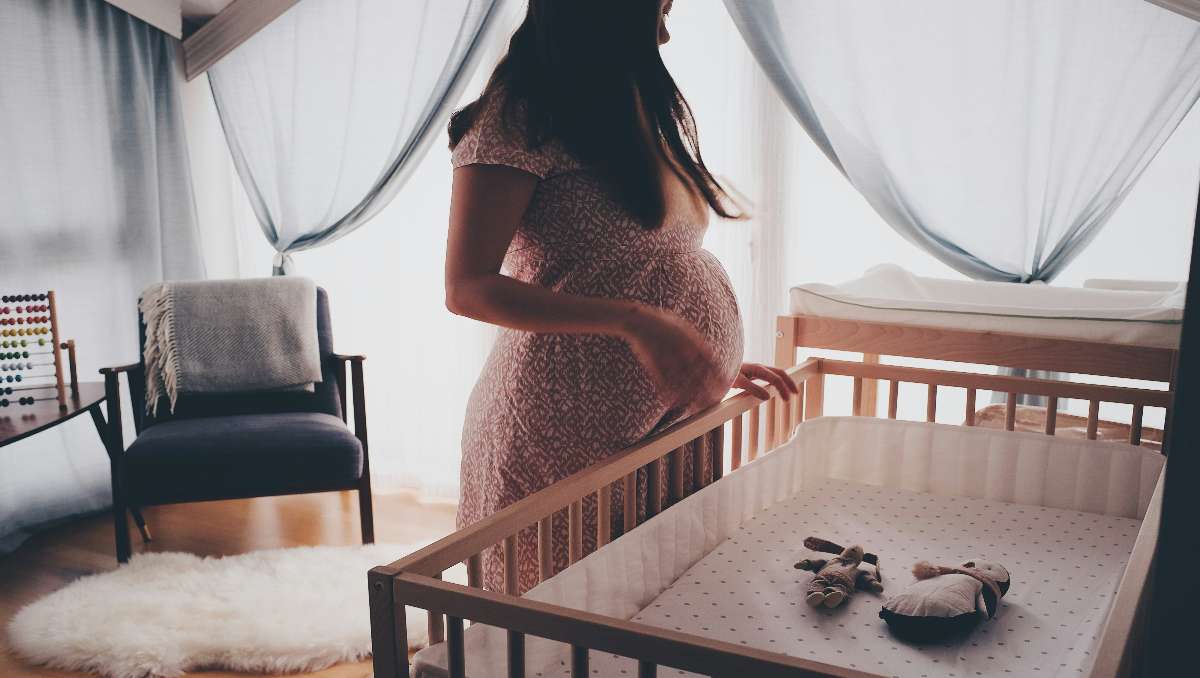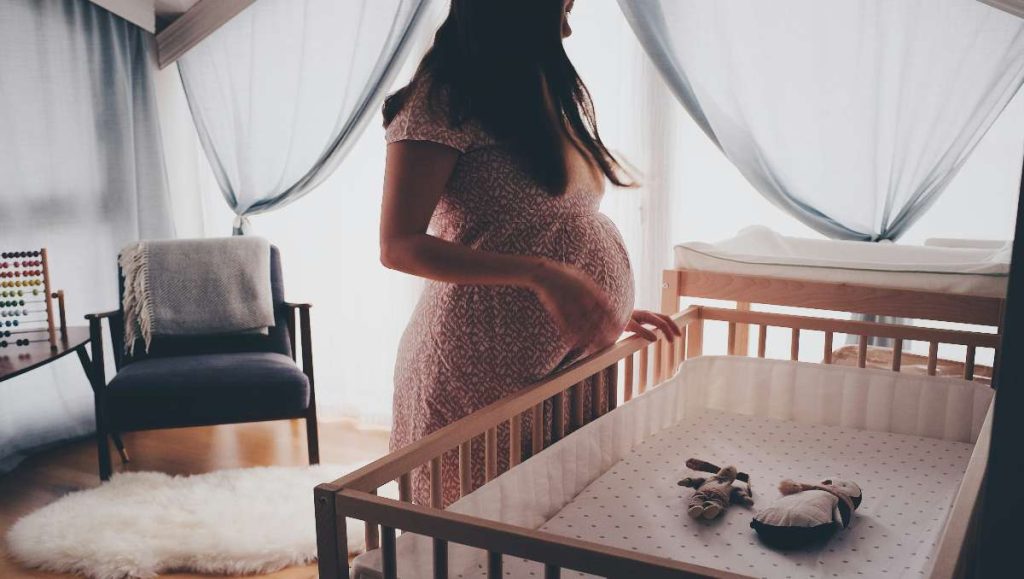
Setting up a nursery is one of the most exciting parts of preparing for your little one’s arrival. It’s a chance to create a space that feels warm, welcoming, and uniquely yours—where your baby will grow, play, and rest. From picking the perfect color scheme to finding furniture that’s both functional and stylish, every choice feels like it matters. But among all the decisions, choosing the right American made cribs stand out. It’s more than just a centerpiece for the room; it’s the safe haven where your baby will sleep, dream, and spend a good chunk of their early months (and hopefully give you a few moments to catch your breath too!).
Key Takeaways
- Prioritize safety features like proper slat spacing, secure hardware, and a snug mattress fit. Select high-quality materials like solid hardwood and opt for non-toxic finishes.
- Conduct regular safety checks and clean the crib regularly.
- Choose American-made cribs to support local manufacturing.
In this guide, we’ll break down everything you need to know to select the best American-made crib for your nursery.
Understanding American Made Crib Safety Standards
The Consumer Product Safety Commission (CPSC) plays a crucial role in ensuring the safety of cribs in the United States. They set and enforce strict safety standards that manufacturers must adhere to. These standards cover a wide variety of aspects, including materials, construction, and design.
A study found that there were an average of 9,561 injuries per year to children under two years old, with 83.2% of those injuries involving cribs. The most common injury was a fall, and the most common diagnosis was soft-tissue injuries.
The key safety features of cribs should include:
- Guardrail Spacing: The spacing between crib slats is critical to prevent infant entrapment. The slats should be no more than 2 3/8 inches apart to prevent a baby’s head from getting stuck.
- Hardware: All hardware, including screws, bolts, and connectors, must be strong and securely fastened to prevent loosening and potential hazards.
- Mattress Fit: The crib mattress should fit snugly within the crib frame, with no more than two fingers of space between the mattress and the sides.
- Drop-Side Mechanisms: Drop-side cribs are no longer allowed in the United States due to serious safety hazards. The drop-side mechanism can malfunction, causing the side to unexpectedly collapse and entrap the infant.
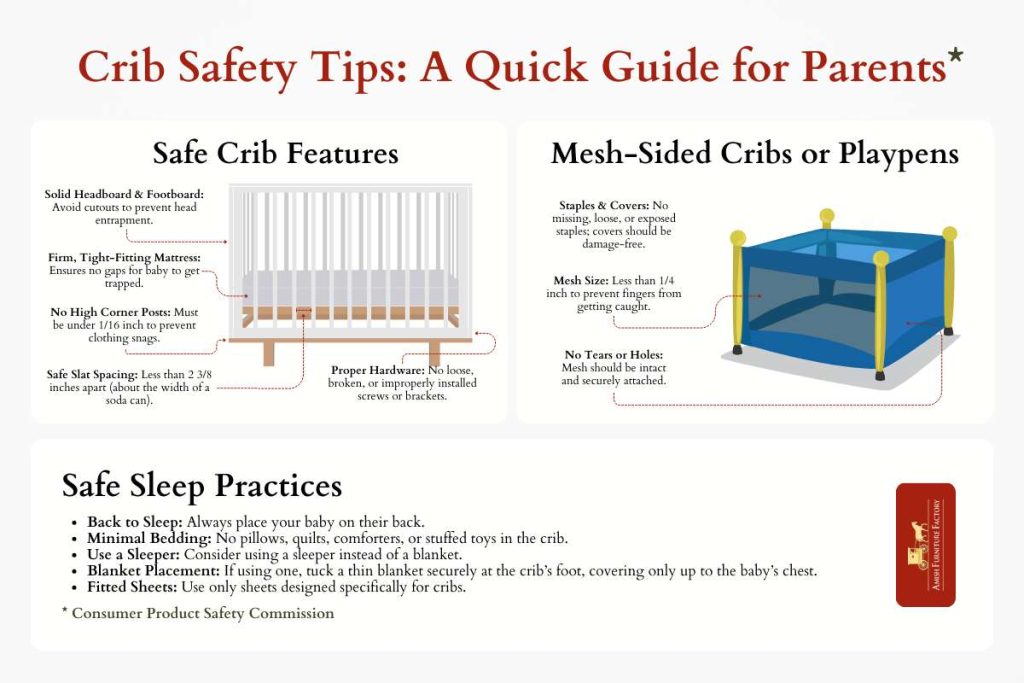
Choosing the Right Crib Materials: Tips and Safety Measures
Selecting the best materials for your baby’s crib is essential for ensuring safety, durability, and a non-toxic sleeping environment. Here’s a guide to help you make an informed choice:
Solid Wood
Solid wood cribs are a conscious choice among modern parents for good reason. Known for their durability, solid wood cribs are built to withstand years of use and even the possibility of being passed down to future generations. Hardwoods like maple, oak, cherry, and pine wood are especially prized for their strength and resistance to wear and tear.
Solid wood cribs are a top choice for modern parents, and for good reason. Known for their long-lasting durability, they can withstand years of use and are often sturdy enough to be passed down to future generations.
Tips for choosing solid wood cribs:
- Opt for cribs made from sustainably sourced wood certified by the Forest Stewardship Council (FSC).
- Avoid cribs made from wood treated with harsh chemicals. Look for labels stating “untreated wood” or “natural finish.”
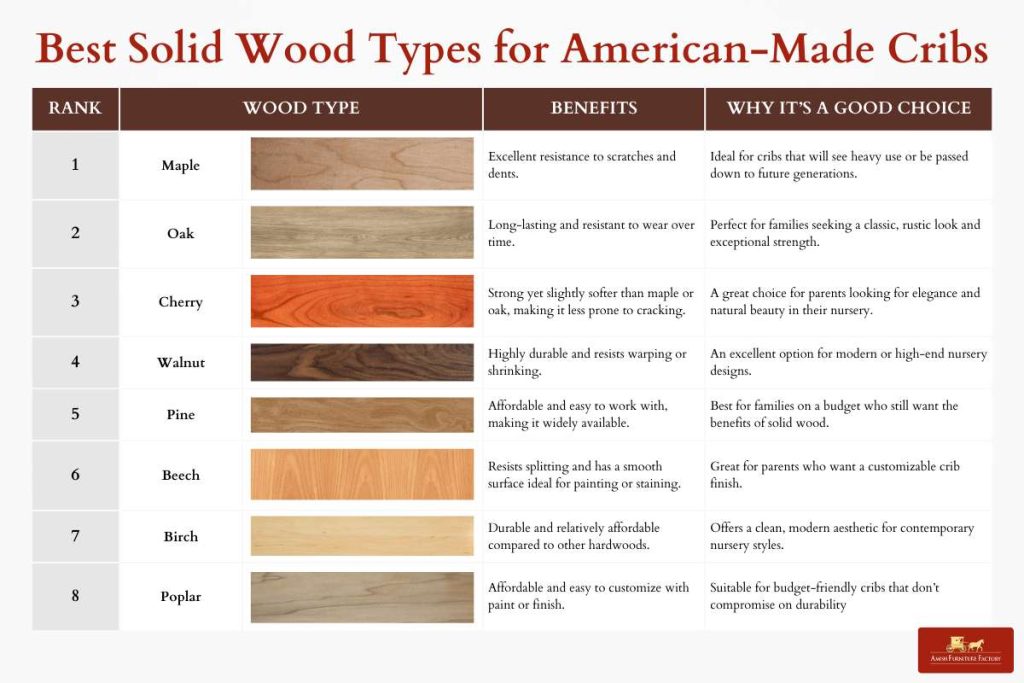
MDF and Particle Board
Cribs made from medium-density fiberboard (MDF) or particle board are budget-friendly options, but they come with potential downsides. These materials are less durable and may be more prone to cracking or chipping over time.
Safety considerations for MDF and particle board:
- Verify that the crib complies with safety certifications, such as CARB Phase 2, which limits harmful formaldehyde emissions.
- Ask for details on the adhesives used during manufacturing to ensure they are non-toxic and low in volatile organic compounds (VOCs).
- If you’re set on a crib made from MDF or particle board, consider models that combine these materials with solid wood for extra durability and safety.
Finishes and Paints
The finishes and paint options used on cribs are just as important as the material itself. Babies often explore their environment with their mouths, making it crucial to choose cribs coated with non-toxic materials, lead-free finishes and paints. Look for certifications like Greenguard Gold, which guarantees low emissions of volatile organic compounds (VOCs), ensuring a healthier indoor environment.
Safety tips:
- Always check for splinters, peeling paint, or rough edges on the crib. These can pose choking or injury risks.
- Avoid vintage or antique cribs that might contain lead-based paint or finishes that don’t meet modern safety standards.
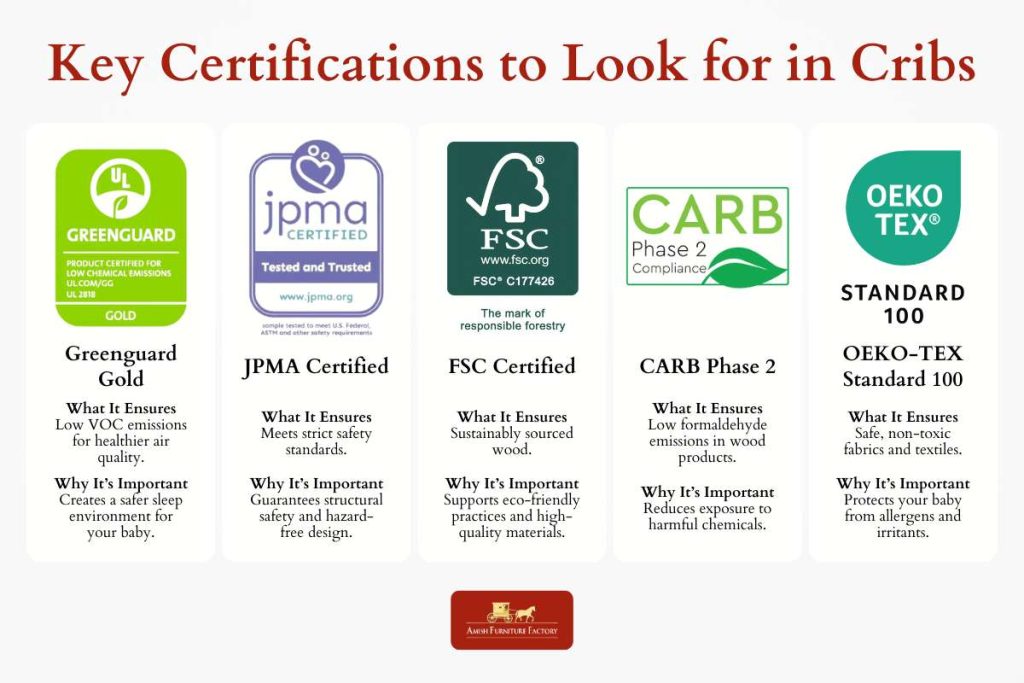
Selecting the Perfect Mattress
Choosing the right mattress is crucial for your baby’s safety and comfort. A firm mattress is essential for infants to reduce the risk of Sudden Infant Death Syndrome (SIDS). A soft mattress can create a dangerous indentation where a baby’s face can become trapped, obstructing their breathing.
Proper fit is equally important. The mattress should fit snugly within the crib frame, with no more than two fingers of space between the mattress and the sides. This prevents gaps where an infant could become wedged and suffocate. When selecting a mattress, look for certifications that ensure safety and quality. The CertiPUR-US certification, for example, guarantees that the mattress meets strict standards for durability, emissions, and overall performance.
Style and Design Considerations
Choosing American made cribs that complements your nursery’s aesthetic is an important consideration. Classic cribs with simple, timeless designs often feature elegant wood finishes and can easily be incorporated into various decor schemes. Modern cribs, on the other hand, may showcase sleek lines, unique shapes, innovative design, and contemporary materials like metal or acrylic.
Convertible cribs offer a practical and cost-effective solution as your child grows. You can also consider cribs with sleek designs and built-in storage features like drawers or shelves to maximize spaces for infants and keep your baby products organized.
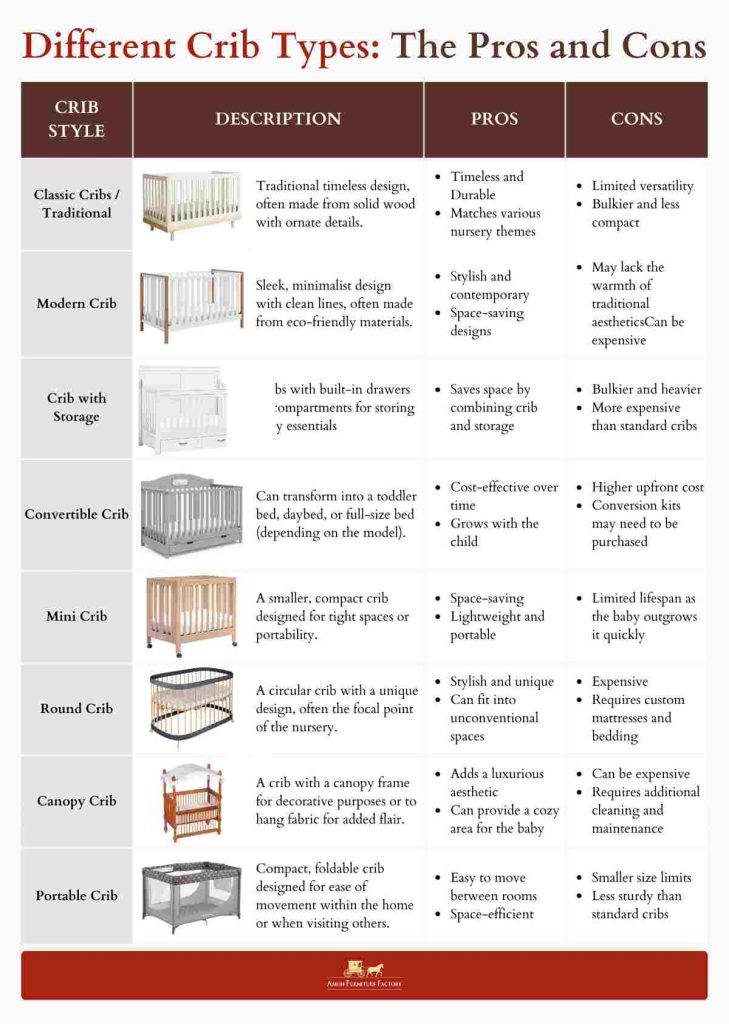
Budgeting For Your Crib
American made cribs typically range in price from a few hundred dollars to well over a thousand dollars. Several factors contribute to this price variation. The type of wood used significantly impacts the cost, with high-quality hardwoods being more expensive than softer woods. The brand and reputation of a renowned manufacturer also play a role. Established brands known for their quality craftsmanship and safety standards often command a higher price.
Finding affordable crib options is possible with some careful planning. Keep an eye out for sales and discounts at local furniture stores or online retailers. Consider purchasing a gently used standard or convertible crib from a reputable source, such as a consignment shop or online marketplace, ensuring it meets all safety standards.
Elevate your nursery with safe, stylish, and sustainably-sourced Amish baby cribs and cradles. Explore our collection today!
How to Assemble Your Crib Safely
Assembling American made cribs requires careful attention to detail and adherence to safety guidelines. Here’s a general step-by-step guide:
- Gather your tools and prepare your workspace: Collect all the necessary tools and choose a clean, flat, and sturdy work surface, such as a large table or a clean floor.
- Inspect all parts: Carefully examine all parts of the crib for any damage or missing components.
- Follow the instructions: Begin assembling the crib step-by-step, ensuring that each piece is securely fastened according to the manufacturer’s instructions.
- Check for stability: Once assembled, gently rock the crib to ensure it is stable and does not wobble.
- Check for sharp edges: Carefully inspect all edges and corners of the crib for any sharp points that could injure your baby.
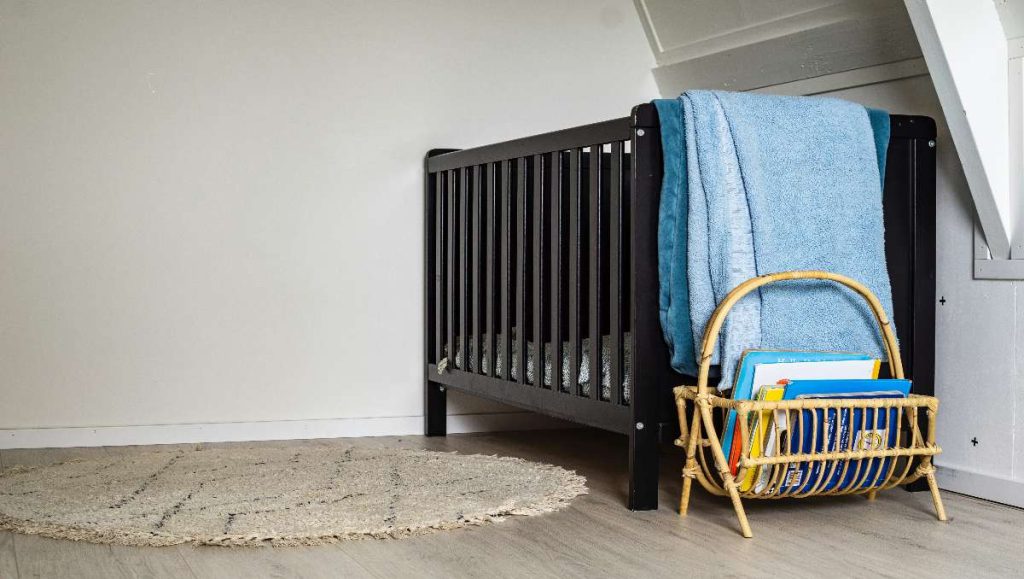
Maintaining Your Crib
Proper maintenance is crucial to ensure your crib remains safe and functional for your child. Conduct regular safety checks of the crib, paying close attention to hardware, slats, mattress, and finish. To clean, wipe down the crib regularly with a damp cloth and mild soap. Avoid using harsh chemicals or abrasive cleaners that could damage the finish.
If you notice any damage or safety concerns, stop using the crib immediately and contact the manufacturer for repair instructions or replacement parts. By following these simple maintenance tips, you can help ensure your crib remains a safe and comfortable haven for your child.
Conclusion: Choosing American Made Cribs Built to Last
Selecting the right crib for your nursery is one of the most important decisions you’ll make as a busy parent. Consider key factors like safety standards, high-quality materials, and design versatility. Ultimately, the best crib is one that fits seamlessly into your lifestyle while meeting your baby’s needs for comfort and safety. By investing in a well-made, American made cribs, you can create a nurturing space for your little one, offering peace of mind and lasting value for years to come.
FAQs
What are the most important safety features to look for in a crib?
When choosing a crib, prioritize safety features such as proper guardrail spacing, a snug-fitting mattress to reduce suffocation risks, sturdy and securely fastened hardware, and compliance with CPSC standards.
How often should I inspect my crib for safety issues?
You should inspect your crib regularly, ideally once a month. Check for loose screws, bolts, or other hardware, and ensure the mattress fits snugly without gaps.
Can I use a used crib? If so, what should I look for?
Yes, you can use a used crib, but it requires careful evaluation. Ensure the crib meets current safety standards (avoid cribs made before 2011, as they may not comply with modern regulations). Check for recalls and verify that all parts and instructions are included.
Are eco-friendly cribs worth the higher price?
Eco-friendly cribs can be worth the investment for their sustainability and safety benefits. These cribs are often made from non-toxic, sustainably sourced materials, making them safer for your baby and better for the environment.
